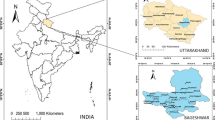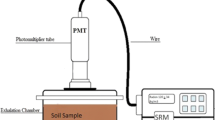Abstract
To investigate the activity concentrations of naturally occurring radionuclides such as 238U, 232Th, and 40K, as well as the presence of radon (222Rn) and thoron (220Rn) in the vicinity of the Aravalli Mountain range in Mahendergarh, India, a comprehensive study was conducted. We meticulously examined soil samples obtained from both field and hill areas using NaI (Tl) detector based on gamma spectroscopy. It is noteworthy that concentrations were found lower than the global average values. Notably, the hill soil samples exhibited a higher activity concentration in comparison to the field soil samples. Overall, in terms of radium equivalent activity (226Ra), gamma absorbed dose rate, and the internal hazard index, our findings did not reveal any significant radiological risks.









Similar content being viewed by others
References
UNSCEAR (1988) Sources, effects and risks of ionizing radiation. United Nations Scientific Committee on the Effects of Atomic Radiation, Report to the General Assembly
Kumar M (2022) Estimation of 222Rn, 220Rn exhalation rate and 226Ra, 232Th, 40K radionuclides in the soil samples of different regions of Gurdaspur district, Punjab. Mater Today Proc 49:3396–3402
Alzubaidi G (2016) Assessment of natural radioactivity levels and radiation hazards in agricultural and virgin soil in the state of Kedah, North of Malaysia. Sci World J. https://doi.org/10.1155/2016/6178103
Johnson S (1991) Natural radiation. Va Miner 37(2):9–16
International Atomic Energy Agency (1973) Regulations for the safe transport of radioactive materials. 96–00725 IAEA/PI/A47E
United Nations Scientific Committee on the Effect of Atomic Radiation (UNSCEAR) (1993) Exposure from natural sources of radiation, United Nations, New York
Anamika K (2020) Assessment of radiological impacts of natural radionuclides and radon exhalation rate measured in the soil samples of Himalayan foothills of Uttarakhand, India. J Radioanal Nucl Chem 323:263–274. https://doi.org/10.1007/s10967-019-06876-0
Venunathan N (2016) Natural radioactivity in sediments and river bank soil of Kallada river of Kerala, South India and associated radiological risk. Radiat Prot Dosimetry 171(2):271–276. https://doi.org/10.1093/rpd/ncw073
Bennett B (1996) Exposure to natural radiation worldwide. In: Proceedings of the fourth international conference on high levels of natural radiation: radiation doses and health effects, Beijing, China, pp 15–23
Paschoa A (2000) More than forty years of studies of natural radioactivity in Brazil. Technology 7(2–3):193–212
Kannan V (2002) Distribution of natural and anthropogenic radionuclides in soil and beach sand samples of Kalpakkam (India) using hyper pure germanium (HPGe) gamma ray spectrometry. Appl Radiat Isot 57(1):109–119. https://doi.org/10.1016/S0969-8043(01)00262-7
Ghiassi Nejad M (2002) Very high background radiation areas of Ramsar, Iran: preliminary biological studies. Health Phys 82(1):87–93
Wei L (2000) An introductory overview of the epidemiological study on the population at the high background radiation areas in Yangjiang, China. J Radiat Res 41(Suppl):S1–S7. https://doi.org/10.1269/jrr.41.S1
Sunta C (1993) A review of the studies of high background areas of the SW coast of India. In: Proceedings of the international conference on high levels of natural radiation, Ramsar, IAEA, pp 71–86
Radhakrishna A (1993) A new natural background radiation area on the southwest coast of India. Health Phys 65(4):390–395
Younis H (2022) Gamma radioactivity and environmental radiation risks of granitoids in central and western Gilgit Baltistan, Himalayas, North Pakistan. Res Phys 37:105509
Karam P (2001) The very high background radiation area in Ramsar, Iran: Public health risk or signal for a regulatory paradigm shift. pp 495–502
Kebwaro J (2011) Radiometric assessment of natural radioactivity levels around Mrima Hill, Kenya. 6(13): 3105–3110. http://www.academicjournals.org/IJPS
UNSCEAR (2000) United Nations scientific committee of the effect of atomic radiation (UNSCEAR). Sources, effects and risks of ionizing radiations. United Nations, New York
Bangotra P (2016) Study of natural radioactivity (226Ra, 232Th and 40K) in soil samples for the assessment of average effective dose and radiation hazards. Radiat Prot Dosimetry 171(2):277–281. https://doi.org/10.1093/rpd/ncw074
Krewski D (2006) A combined analysis of North American case-control studies of residential radon and lung cancer. J Toxicol Environ Health A 69(7–8):533–597. https://doi.org/10.1080/15287390500260945
Darby S (2005) Radon in homes and risk of lung cancer: collaborative analysis of individual data from 13 European case control studies. BMJ 330(7485):223. https://doi.org/10.1136/bmj.38308.477650.63
Das B (2000) Cancer pattern in Haryana: twenty-one years experience. Health Adm 17(1):29
Chahal K (2022) Estimation of surface exhalation rate of thoron (220 Rn) in soil samples of Aravalli Mountain range region of district Mahendergarh, Haryana, India using alpha detector Smart Rnduo. In: Proceedings of the DAE-BRNS symposium on Nuclear Physics V, pp 66
Nazaroff W (1992) Radon transport from soil to air. Rev Geophys 30(2):137–160. https://doi.org/10.1029/92RG00055
Sahu P (2013) Radon emanation from low-grade uranium ore. J Environ Radioact 126:104–114. https://doi.org/10.1016/j.jenvrad.2013.07.014
Kumar A (2014) Modeling of indoor radon concentration from radon exhalation rates of building materials and validation through measurements. J Environ Radioact 127:50–55. https://doi.org/10.1016/j.jenvrad.2013.10.004
Devi V (2019) A study on radionuclides content and radon exhalation from soil of Northern India. Environ Earth Sci 78:1–12. https://doi.org/10.1007/s12665-019-8512-9
Chauhan R (2016) Ventilation effect on indoor radon–thoron levels in dwellings and correlation with soil exhalation rates. Indoor Built Environ 25(1):203–212. https://doi.org/10.1177/1420326X14542887
Chauhan R (2011) Radon exhalation rates from stone and soil samples of Aravali hills in India. 9(1): 57–61
Mann N (2015) Radon-thoron measurements in air and soil from some districts of northern part of India. Nucl Technol Radiat Protect 30(4):294–300
Singh P (2016) Theoretical modeling of indoor radon concentration and its validation through measurements in South-East Haryana, India. J Environ Manag 171:35–41. https://doi.org/10.1016/j.jenvman.2016.02.003
Al-Shboul K (2023) Unraveling the complex interplay between soil characteristics and radon surface exhalation rates through machine learning models and multivariate analysis. Environ Pollut. https://doi.org/10.1016/j.envpol.2023.122440
Kanyan N (2020) Geochemistry and petrogenesis of Narnaul Pegmatites in Delhi Supergroup rocks, Narnaul area, southern Haryana, India. J Nepal Geol Soc 60:87–102. https://doi.org/10.3126/jngs.v60i0.31268
Ibrahiem N (1993) Measurement of radioactivity levels in soil in the Nile Delta and Middle Egypt. Health Phys 64(6):620–627
Saleh M (2014) Assessment of radiological health implicat from ambient environment in the Muar district, Johor, Malaysia. Radiat Phys Chem 103:243–252. https://doi.org/10.1016/j.radphyschem.2014.05.054
Melissinos A (2003) Experiments in modern physics. Gulf Professional Publishing
Durusoy A (2017) Determination of radioactivity concentrations in soil samples and dose assessment for Rize Province, Turkey. J Radiat Res Appl Sci 10(4):348–352. https://doi.org/10.1016/j.jrras.2017.09.005
Singh B (2021) Monitoring of natural radionuclides by alpha scintillometry and gamma spectrometry techniques in soil of district Palwal, Southern Haryana, India. Int J Environ Anal Chem. https://doi.org/10.1080/03067319.2021.2016726
Mann N (2018) Measurement of radium, thorium, potassium and associated hazard indices from the soil samples collected from Northern India. Indoor Built Environ 27(8):1149–1156. https://doi.org/10.1177/1420326X17696136
United Nations Scientific Committee on the Effects of Atomic Radiation (2000) Sources and Effects of Ionizing Radiation, United Nations Scientific Committee on the Effects of Atomic Radiation (UNSCEAR) 2000 Report, Volume I: Report to the General Assembly, with Scientific Annexes-Sources. United Nations
Beretka J (1985) Natural radioactivity of building materials, industrial wastes and byproducts. Health Phys 48:87–95
Guidebook A (1989) Measurement of radionuclides in food and the environment. International Atomic Energy Agency, Vienna
Joel E (2019) Investigation of natural environmental radioactivity concentration in soil of coastaline area of Ado Odo/Ota Nigeria and its radiological implications. Sci Rep 9(1):4219. https://doi.org/10.1038/s41598-019-40884-0
Saito K (1995) Gamma ray fields in the air due to sources in the ground. Radiat Prot Dosimetry 58(1):29–45. https://doi.org/10.1093/oxfordjournals.rpd.a082594
Gaware J (2011) Development of online radon and thoron monitoring systems for occupational and general environments. In the Forthcoming issue
Sahoo B (2007) Estimation of radon emanation factor in Indian building materials. Radiat Meas 42(8):1422–1425. https://doi.org/10.1016/j.radmeas.2007.04.002
Vaupotič J (1992) Alpha scintillation cell for direct measurement of indoor radon. J Environ Sci Health Part A 27(6):1535–1540
Porstendörfer J (1994) Properties and behaviour of radon and thoron and their decay products in the air. J Aerosol Sci 25(2):219–263. https://doi.org/10.1016/0021-8502(94)90077-9
De Martino S (1998) Radon emanation and exhalation rates from soils measured with an electrostatic collector. Appl Radiat Isot 49(4):407–413. https://doi.org/10.1016/S0969-8043(96)00300-4
Kanse S (2013) Powder sandwich technique: a novel method for determining the thoron emanation potential of powders bearing high 224Ra content. Radiat Meas 48:82–87. https://doi.org/10.1016/j.radmeas.2012.10.014
Sahoo B (2014) Thoron interference in radon exhalation rate measured by solid state nuclear track detector based can technique. J Radioanal Nucl Chem 302:1417–1420. https://doi.org/10.1007/s10967-014-3580-5
Tuccimei P (2006) Simultaneous determination of 222Rn and 220Rn exhalation rates from building materials used in Central Italy with accumulation chambers and a continuous solid state alpha detector: influence of particle size, humidity and precursors concentration. Appl Radiat Isot 64(2):254–263. https://doi.org/10.1016/j.apradiso.2005.07.016
Poojitha C (2020) Assessment of radon and thoron exhalation from soils and dissolved radon in ground water in the vicinity of elevated granitic hill, Chikkaballapur district, Karnataka, India. Radiat Prot Dosimetry 190(2):185–192
Semwal P (2018) Measurement of 222 Rn and 220 Rn exhalation rate from soil samples of Kumaun Hills, India. Acta Geophys 66(5):1203–1211
Kaur M (2021) Measurement of radionuclide contents and 222 Rn/220 Rn exhalation rate in soil samples from the sub-mountainous region of India. Arab J Geosci 14(9):1–16
Kaur M (2018) Study of radon/thoron exhalation rate, soil-gas radon concentration, and assessment of indoor radon/thoron concentration in Siwalik Himalayas of Jammu & Kashmir. Hum Ecol Risk Assess Int J 24(8):2275–2287
Chauhan R (2014) Estimation of dose contribution from 226Ra, 232Th and 40K radon exhalation rates in soil samples from Shivalik foot hills in India. Radiat Prot Dosimetry 158(1):79–86
Babu P (1993) Tin and Rare Metal Pegmatites of the Bastar-Koraput Pegmatite Belt, Madhya Pradesh and Orissa, India. Characterisation and Classification. Geol Soc India 42(2):180–190
Kumar P (2019) Itacolumite (Flexible sandstone) from Kaliana, Charkhi Dadri District, Haryana, India. J Geol Soc India 93:278–284
Dina NT (2022) Natural radioactivity and its radiological implications from soils and rocks in Jaintiapur area, North-east Bangladesh. J Radioanal Nucl Chem 331(11):4457–4468
Akhtaruzzaman M (2014) Morphological, physical and chemical characteristics of hill forest soils at Chittagong University, Bangladesh. Open J Soil Sci 4:26–35. https://doi.org/10.4236/ojss.2014.41004
Chowdhury CR (2020) Radionuclide activity concentration in soil, granites and water in a fluorosis endemic area of India: an oral health perspective. J Oral Biol Craniofacial Res 10(3):259–262
Yadav S (2019) Fluoride distribution in underground water of district Mahendergarh, Haryana, India. Appl Water Sci 9:1–11
Acknowledgements
The authors are thankful to the inhabitants of the studied area for their cooperation during the fieldwork and thankful to the Guru Jambheswar University of Science and Technology, Hisar for providing experimental facilities and support. One of the authors Kavita Chahal thankful to Central University of Haryana for providing a Research fellowship.
Author information
Authors and Affiliations
Corresponding author
Ethics declarations
Conflict of interest
The authors declare that they have no known conflicting financial interests or personal relationships that could have appeared to influence the findings represented in this paper. The authors declare that there is no conflict of interest in the publication of the paper.
Additional information
Publisher's Note
Springer Nature remains neutral with regard to jurisdictional claims in published maps and institutional affiliations.
Rights and permissions
Springer Nature or its licensor (e.g. a society or other partner) holds exclusive rights to this article under a publishing agreement with the author(s) or other rightsholder(s); author self-archiving of the accepted manuscript version of this article is solely governed by the terms of such publishing agreement and applicable law.
About this article
Cite this article
Chahal, K., Kumar, S., Budhwar, S. et al. An assessment of radionuclides level, radon and thoron exhalation rate in hill and field soil of Mahendergarh district in Haryana, India. J Radioanal Nucl Chem (2024). https://doi.org/10.1007/s10967-024-09494-7
Received:
Accepted:
Published:
DOI: https://doi.org/10.1007/s10967-024-09494-7




